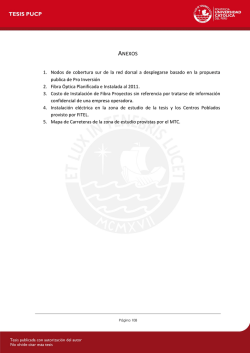
Aspectos técnicos
Detección del Ganglio Centinela en Patología Abdominal Dra. C Balagué DISEMINACIÓN LINFÁTICA Patrón ordenado, secuencial y predecible a través de los conductos linfáticos. GANGLIO CENTINELA Ganglios con el drenaje más directo desde la neoplasia primaria y con mayor potencial de albergar metástasis. ASPECTOS TECNICOS ASPECTOS CONCEPTUALES Aspectos conceptuales •Mejorar la estadificación •Cambio en la técnica quirúrgica aplicada Estadío II (N0) Estadío III (N1) QT adyuvante QT adyuvante No diferencias supervivencia Recurrencia 20-30% INFRAESTADIFICACION 10-20% CASOS AIM IN STAGE II MEJORAR EL ESTADIAJE DE LOS GANGLIOS More sections of nodes Inmunohistochemistry RT-PCR ELEVADO COSTE ECONOMICO Y DE TIEMPO OBJETIVO DE LA DETERMINACION DEL GANGLIO CENTINELA EN CANCER DE COLON Identificar y evaluar los ganglios • linfáticos con más posibilidad de estar Identify and evaluate the lymph nodes with more possibility of being afected afectos Identificar los ganglios linfáticos más • Identify the lymph nodes out of the allá del territorio linfático conventional lymphatic drainage. convencional. SLNM ‘.. im pa • 33 studies - 1794 patients (1201 colon / 332 rectum) Sentinel Lymph node mapping in colorectal cancer: Meta-analysis of • False negative - 9% - is necessary to the literature. understand it before to standardize its use in Colo-rectal Cancer. Des Guetz et al 2006 • Prognostic implications of micrometastases – Further studies are needed. Could lymphatic mapping and sentinel node biopsy provide oncological providence for local resectional techniques for colon cancer? A review of the literature. RA Cahill 2008 • 52 studies - 3390 patients • Standardize the technical approach is necessary. Heterogeneity of studies. • Lower detection – Higher index of false negative CONTROVERSIES POSSIBILITY IMPLICATIONS OF MICROMETASTASES OTHER INVOLVED FACTORS Angiogeneses: neovascularization implants < 2 mm > 2mm. CONTROVERSIES POSSIBILITY IMPLICATIONS OF MICROMETASTASES OTHER INVOLVED FACTORS Angiogeneses: neovascularization implants < 2 mm > 2mm. CONTROVERSIAS POSIBILIDAD IMPLICACIONES DE LAS MICROMETASTASIS OTROS FACTORES IMPLICADOS Ganglio centinela + (micrometastasis) VEGF niveles EVOLUCION CLINICA MATERIAL AND METHODS •ADK colon pT2-3 N0 M0 Material y métodos •Colectomia asistida por laparoscopia •Detección del ganglio centinela con Azul Metileno ex vivo •Determinación de niveles de VEGF ASPECTOS TECNICOS • Lymphazurin ® (Isosulfan blue 1%) • Methilene blue • 2 ml distribuidos en los 4 • 2cuadrantes ml en 4 quadrants • Subseroso • Submucoso • Tamaño Cantidad Cantidad Marcador • Ex vivo: • Massage 5 min Tipo Inoculación • Laparoscopia Cirugía Aspectos técnicos •Inoculación: Submucosa vs Subserosa Aspectos técnicos •Inoculación: Submucosa vs Subserosa Aspectos técnicos •Inoculación: Submucosa vs Subserosa Ex vivo – In vivo Aspectos técnicos •Inoculación: Submucosa vs Subserosa Ex vivo – In vivo •Marcador: Tinción vs Radioisótopo Aspectos técnicos •Inoculación: Submucosa vs Subserosa Ex vivo – In vivo •Marcador: Tinción vs Radioisótopo Heterogeneidad entre los grupos de trabajo Análisis de resultados?? MATERIAL AND METHODS 101 pacientes: 45 mujeres /56 hombres Edad media 73 años IMC: 27 Tamaño tumoral Localización: 5 cm 39 colon derecho 5 colon transverso 13 colon izquierdo 37 sigma 7 recto alto Enero / 2007 – Abril / 2011 RESULTS Cirugía: 42 hemicolectomia derecha, 11 hemicolectomia izquierda 36 sigmoidectomia, 9 reseccion anterior, 2 colectomia subtotal Abordaje: 86 Laparoscoiay (85%) 15 Abierto Tiempo operatorio: 121 min RESULTS Complicac Postop 20% Reoperacion – 6% (6 casos) Hemoperitoneo 1% (1 caso) Dehiscencia 5% (5 casos) Estancia hospitalaria 9 dias Mortalidad Postoperatoria 2% (2 pacientes) Seguimiento 98 pacientes RESULTS •TNM: Tumor pT0 2 pT1 8 pT2 21 pT3 60 pT4 10 RESULTS •Sentinel lymph node related: Mean obtained lymph nodes Mean obtained sentinel lymph nodes 15 2 Sentinel lymph node detection 91 % (92 / 101 patients ) 5 T3N0 / 1 T4N0 / 2 T2N1 / 1 T2N0 RESULTS •Sentinel lymph node related: 92 patients Conventional lymph node detection Positive Negative SLN Detection Positive 15 9 24 Negative 9 59 68 24 68 92 RESULTS •Sentinel lymph node related: 92 patients Negative Predictive Value (59 / 9 + 59) Positive Predictive Value (15 / 9 + 15) 87% Suprastadification (9/ 9 + 59) 13% 63% RESULTS •Follow up - 13 months •Recurrence: •T2: •T3: •T4: 10% (10 / 98) 5% (1 / 21) 12% (7 / 57) 20% (2 / 10) •SLN -: 7% (4 / 56) •LN +: 25% (4 / 24) •Only SLN +: 22% (2 / 9) •No diferences for tumor size, lymph nodes number obtained, postop complication rates, tipe of surgery. RESULTS •QT: 35% (34 / 98) Recurrence QT no 9% (6 / 64) QT yes 12% (4 / 34) RESULTS •VEGF related: •Patients with no recurrence - 427 •Patients with recurrence 600 All patients with recurrence – VEGF > 400 Patient with SLN + recurrence – VEGF: 1006 Patients with SLN + no recurrence – VEGF < 400 no significant diference CONCLUSION •Patients with negative lymph nodes by conventional study showed diferences in recurrence rate when the SLN was also negative (recurrence of 7%) or when SLN was the only positive one (22%). •We have not still observed diferences in reference to the VEGF levels but the sample is not large enough. CONCLUSION •The technical approach is feasible The radionuclide study could improve detection in obese patients Radionuclide vs Methilene Blue Sentinella SLN in Low Rectal Cancer LRC 20% iliac lymph nodes Independent of mesorectum RT-QT effective + Sequelae from surgery Surgery rejected T2-T3s / N0 no QTRT SLN – iliac lymph nodes in low rectal cancer (< 8 cm anal margin) Patients with low rectal cancer No neoadjuvant QT-RT Preparation of colon 99Tc Submucosal inoculation by endoscopy Laparoscopic TME Study of iliac nodes Ganglio centinela en Patología esofago‐gástrica Ganglio centinela en Patología colo-rectal Sentinel Lymph Node Detection in Colo‐Rectal Cancer Dra. C Balagué
© Copyright 2024

